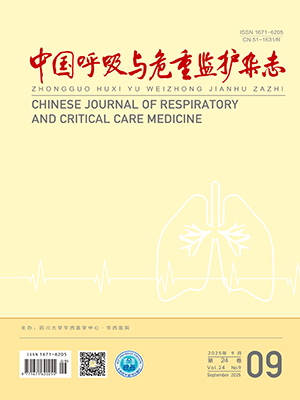| 1. |
Huang KW, Yang T, Xu JY, et al. Prevalence, risk factors, and management of asthma in China: a national cross-sectional study. Lancet, 2019, 394(10196): 407-418.
|
| 2. |
林江涛, 王文巧, 周新, 等. 我国30个省市城区门诊支气管哮喘患者控制水平的调查结果. 中华结核和呼吸杂志, 2017, 40(7): 494-498.
|
| 3. |
王行之, 吴诚, 张娟, 等. 运动对哮喘的影响及哮喘患儿运动处方研究进展. 中国实用儿科杂志, 2021, 36(09): 714-720.
|
| 4. |
石月, 陈佩杰, 李斐, 等. 运动、支气管痉挛与哮喘—厘清、正视与平衡. 体育科学, 2018, 38(8): 75-85.
|
| 5. |
朱巧巧. 成年哮喘患者日常运动和哮喘控制的相关性研究. 中国社区医师, 2016, 32(8): 76-76.
|
| 6. |
Parsons JP, Craig TJ, Stoloff SW, et al. Impact of exercise-related respiratory symptoms in adults with asthma: Exercise-Induced Bronchospasm Landmark National Survey. Allergy Asthma Proc, 2011, 32(6): 431-437.
|
| 7. |
Boulding R, Stacey R, Niven R, et al. Dysfunctional breathing: a review of the literature and proposal for classification. Eur Respir Rev, 2016, 25(141): 287-294.
|
| 8. |
林鉴, 郝继光. 肺功能检查和呼出气一氧化氮离线式检测在学龄前哮喘患儿管理中的应用. 中国妇幼保健, 2021, 36(6): 1301-1304.
|
| 9. |
刘杰, 叶继伦, 文斌, 等. 多参数运动心肺功能测试系统的初步应用. 中国医学物理学杂志, 2021, 38(03): 344-349.
|
| 10. |
Sylvester KP, Clayton N, Cliff I, et al. ARTP statement on pulmonary function testing 2020. BMJ Open Respir Res, 2020, 7(1): e000575.
|
| 11. |
车琳. 心肺运动试验临床操作新进展. 中国实用内科杂志, 2022, 42(5): 367-370.
|
| 12. |
张也, 孙兴国, 郝璐, 等. Max试验验证个体化症状限制性心肺运动试验为最大极限运动临床研究. 中国全科医学, 2019, 22(20): 2441-2447, 2454.
|
| 13. |
Bhatia R. Cardiopulmonary exercise testing for pediatric exercise-induced dyspnea especially in patients whose asthma treatment failed. Ann Allergy Asthma Immunol, 2020, 124(1): 101-102.
|
| 14. |
邢双涛, 冯世杰, 张一凡, 等. 不同运动方式对哮喘患儿肺功能影响的网状Meta分析. 河南师范大学学报(自然科学版), 2023(2): 149-156.
|
| 15. |
中华医学会呼吸病学分会哮喘学组. 支气管哮喘防治指南(2020年版). 中华结核和呼吸杂志, 2020, 43(12): 1023-1048.
|
| 16. |
王丹, 李瑾, 高民, 等. 男性非小细胞肺癌合并慢性阻塞性肺疾病患者运动耐量、通气效率特点临床研究. 中国康复医学杂志, 2021, 36(9): 1094-1100.
|
| 17. |
彭千, 谢航宇, 刘春涛. 肺通气灌注显像在定量评估哮喘患者肺功能中的应用. 中国呼吸与危重监护杂志, 2021, 20(4): 247-253.
|
| 18. |
Hansen JE, Sue DY, Wasserman K. Predicted values for clinical exercise testing. Am Rev Respir Dis, 1984, 129(2 Pt 2): S49-S55.
|
| 19. |
Moreau J, Socchi F, Renoux MC, et al. Cardiopulmonary fitness in children with asthma versus healthy children. Arch Dis Child, 2023, 108(3): 204-210.
|
| 20. |
Sanz SV, Diez VI, Donadio MVF, et al. Comparison of physical fitness between healthy and mild to moderate asthmatic children with exercise symptoms: a cross sectional study. Pediatr Pulmonol, 2021, 56(8): 2512-2521.
|
| 21. |
Laveneziana P, Bruni GI, Presi I, et al. Tidal volume inflection and its sensory consequences during exercise in patients with stable asthma. Respir Physiol Neurobiol, 2013, 185(2): 374-379.
|
| 22. |
Boutou AK, Daniil Z, Pitsiou G, et al. Cardiopulmonary exercise testing in patients with asthma: What is its clinical value? Respir Med, 2020, 167: 105953.
|
| 23. |
Ghozali MT, Mohany M, Milošević M, et al. Impact of a mobile-app assisted self-management educational intervention on the scores of asthma control test (ACT) questionnaire among young asthmatic patients. Res Social Adm Pharm, 2023, 19(10): 1354-1359.
|
| 24. |
Haverkamp HC, Dempsey JA, Pegelow DF, et al. Treatment of airway inflammation improves exercise pulmonary gas exchange and performance in asthmatic subjects. J Allergy Clin Immunol, 2007, 120(1): 39-47.
|
| 25. |
Collins SÉ, Phillips DB, Brotto AR, et al. Ventilatory efficiency in athletes, asthma and obesity. Eur Respir Rev, 2021, 30(161): 200206.
|
| 26. |
O'Donnell DE, Elbehairy AF, Berton DC, et al. Advances in the evaluation of respiratory pathophysiology during exercise in chronic lung diseases. Front Physiol, 2017, 8: 245917.
|
| 27. |
Rinaldo RF, Masseroni A, Vigo B, et al. Patients with severe asthma show reduced exercise capacity assessed with cardiopulmonary exercise test. Eur Respir J, 2019, 54(S63): PA4141.
|
| 28. |
Rinaldo RF, Imeri G, Mondoni M, et al. Does the severity of asthma affect exercise capacity and daily physical activity? J Asthma, 2023, 60(8): 1622-1631.
|




